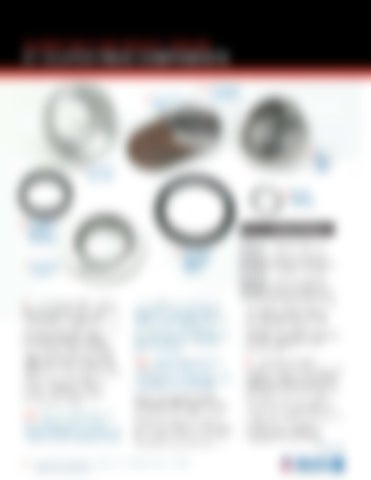ALLISON 1000 & 2000 PRODUCT FAMILIES
C1 CLUTCH PACK COMPONENTS A. C1 Clutch Pack
B. C1 Clutch Backplate
E. C1 Drive Hub
F. C1 Piston Housing
G. Thrust Bearing
D. C1 Return Spring Assembly H. C1 Clutch Balance Piston
C. C1 Clutch Piston
A. Inspect friction plate contact faces for excessive wear, embedded metal particles, cracking and distortion. Inspect the plate splines for burrs, cracks and damaged spline teeth. Replace the plate if spline damage cannot be repaired using a soft stone or crocus cloth. Minimum allowable friction plate thickness is 2.375mm (0.0935 inch). Minimum allowable oil groove depth is 0.20mm (0.008 inch). Maximum allowable coning is 0.225mm (0.009 inch). NOTE: Anti-freeze (glycol) and/or
water will adversely affect the bonding agent between the friction material and steel core. Replace any
44
ALLISON
TRANSMISSION
2005 General Motors Corporation.
ID
Minimum Thickness
2420
11.400 mm (0.4488 inch)
6221/8521
11.840 mm (0.4661 inch)
6222/8522 12.280 mm (0.4835 inch) 6223/8523
12.730 mm (0.5012 inch)
6224/8524
13.180 mm (0.5189 inch)
6225/8525
13.630 mm (0.5366 inch)
friction plates which have been exposed to water and/or glycol. Friction material which is loose or flaking indicates that the plates have been exposed to glycol and/or water. Reference SIL 18-TR-98, Rev. A for details.
crocus cloth. Replace the plate if any tangs are broken, bent or otherwise distorted. Minimum allowable plate thickness is 2.135mm (0.0841 inch). Maximum allowable coning is 0.20mm (0.0079 inch).
NOTE: Battered and worn spline
B. Inspect the C1 clutch
teeth may be an indicator of driveline issues. Replace the clutch plates and check the driveline.
backplate. Replace the backplate if has burrs, scoring or other damage which cannot be repaired using a soft stone or crocus cloth. Replace the backplate if it is cracked or broken. Check the backplate for coning. Replace the backplate if any coning is detected. Minimum allowable plate thickness is indicated in the chart above.
Inspect reaction plate contact surfaces for chips, cracks, grooves, scoring and signs of discoloration. Inspect reaction plate tangs for chips, cracks and signs of battering. Replace the plate if damage cannot be repaired using a soft stone or TECHNICIANS’
GUIDE
(continued)


























